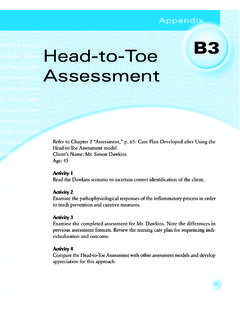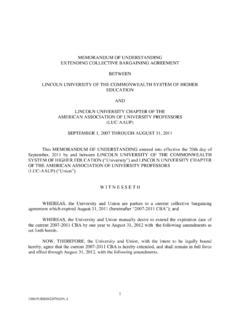Transcription of UHI 10e Chapter02 Table 2-A Comprehensive …
1 Table 2-A Comprehensive history of health care reimbursement YEAR EVENT DESCRIPTION. 1860 First health The Franklin health Assurance Company of Massachusetts was the first commercial insurance policy insurance company in the United States to provide private health care coverage for injuries not resulting in death. 1880 Expansion of private Sixty additional insurance companies offer health insurance policies. Such policies health insurance covered loss of income and a limited number of illnesses ( , typhoid, scarlet fever, and smallpox). 1900 Self-pay prevails Most Americans continued to pay their own health care expenses, which usually meant either charity care or no care . 1908 Workers' President Theodore Roosevelt signed legislation to provide workers' compensation for compensation certain federal employees in unusually hazardous jobs.
2 Workers' compensation is a program mandated by federal and state governments, which requires employers to cover medical expenses and loss of wages for workers who are injured on the job or who have developed job-related disorders. 1915 Campaign for health The American Association of Labor Legislation (AALL) drafted model health insurance insurance begins legislation, which limited coverage to the working class and others who earned less than $1,200 a year, including their dependents. The American Medical Association (AMA). supported this legislation, but it was never passed into law. 1916 FECA The Federal Employees' Compensation Act (FECA) replaced the 1908 workers'. compensation legislation, and civilian employees of the federal government were provided medical care , survivors' benefits, and compensation for lost wages.
3 The Office of Workers' Compensation Programs (OWCP) administers FECA as well as the Longshore and Harbor Workers' Compensation Act of 1927 and the Black Lung Benefits Reform Act of 1977. 1920 Introduction of The first contracts between employers and local hospitals and physicians were prepaid health plans developed. Participating hospitals and physicians performed specified medical services for a predetermined fee that was paid on either a monthly or yearly basis. These prepaid health plans were the forerunner of today's managed care plans. 1921 Indian health The Snyder Act of 1921 and the Indian health care Improvement Act (IHCIA) of 1976. Service pro-vided legislative authority for Congress to appropriate funds specifically for the care of Native Americans, creating and supporting the Indian health Service (IHS).
4 1929 First Blue Cross Justin Ford Kimball, an official at Baylor University in Dallas, introduced a plan to policy guarantee schoolteachers 21 days of hospital care for $6 a year. Other groups of employees in Dallas joined, and the idea attracted nationwide attention. This is generally considered the first Blue Cross plan. 1930 health care reform The Committee on the Cost of Medical care (CCMC) was funded by charitable is initiated organizations to address concerns about the cost and distribution of medical care . It recommended the allocation of national resources for health care and that voluntary health insurance be provided to cover medical costs. This initiative failed. 1939 Wagner National The Tactical Committee on Medical care drafted the Wagner National health Act, which health Act of 1939 proposed that a federally funded national health program be administered by states and localities.
5 The proposal called for compulsory national health insurance and a payroll tax. Extensive national debate occurred, but Congress did not pass it into law. 1. Table 2-A Comprehensive history of health care reimbursement (continued). YEAR EVENT DESCRIPTION. Blue Cross symbol Blue Cross symbol was officially adopted by a commission of the American Hospital Association (AHA) as the national emblem for plans that met certain guidelines. Blue Shield The first Blue Shield plan was founded in California. The Blue Shield concept grew out of the lumber and mining camps of the Pacific Northwest at the turn of the century. Employers wanted to provide medical care for their workers, so they paid monthly fees to medical service bureaus, which were composed of groups of physicians.
6 1940s Group health To attract wartime labor during World War II, group health insurance was offered to full- insurance time employees. The insurance was not subject to income or Social Security taxes, making it an attractive part of an employee benefit package. Group health insurance is health care coverage available through employers and other organizations ( , labor unions, rural and consumer health cooperatives); employers usually pay part or all of premium costs. It was during this time that more group medical practices were formed, which consisted of three or more health care providers who shared equipment, supplies, and personnel, and who divided income by a prearranged formula. 1945 Universal Harry Truman was one of the first American presidents to support a plan for universal Comprehensive Comprehensive national health insurance , including private insurance for those who national health could afford it and public welfare services for the poor.
7 The legislation was not passed insurance into law. 1946 Hill-Burton Act The Hill-Burton Act provided federal grants for modernizing hospitals that had become obsolete because of a lack of capital investment during the Great Depression and WWII. (1929 to 1945). In return for federal funds, facilities were required to provide services free or at reduced rates to patients unable to pay for care . Blue Shield symbol The Association of Medical care Plans, with the Blue Shield symbol as an emblem, was is created created as a national coordinating agency for physician-sponsored health insurance plans. 1947 Taft-Hartley Act The Taft-Hartley Act of 1947 amended the National Labor Relations Act of 1932, restoring a more balanced relationship between labor and management. An indirect result of Taft-Hartley was the creation of third-party administrators (TPAs), which administer health care plans and process claims, thus serving as a system of checks and balances for labor and management.
8 1948 ICD The World health Organization (WHO) developed the International Classification of Diseases (ICD), which is a classification system used to collect data for statistical purposes. Codes were later reported for hospital inpatient and physician office reimbursement purposes. Inpatients are admitted to a hospital for treatment with the expectation that the patient will remain in the hospital for a period of 24 hours or more. Blue Shield symbol The Blue Shield symbol was informally adopted in 1948 by a group of nine plans known is officially adopted as the Associated Medical care Plans, which eventually became the National Association of Blue Shield Plans. 1950 Major medical insurance companies began offering major medical insurance , which provided insurance is offered coverage for catastrophic or prolonged illnesses and injuries.
9 Most of these programs incorporate large deductibles and lifetime maximum amounts. A deductible is the amount for which the patient is financially responsible before an insurance policy provides payment. A lifetime maximum amount is the maximum benefits payable to a health plan participant. 2. Table 2-A Comprehensive history of health care reimbursement YEAR EVENT DESCRIPTION. 1956 Dependents' The Dependents' Medical care Act of 1956 was signed into law and provided health care Medical care Act of to dependents of active military personnel. 1956. 1960 Blue Cross The Blue Cross Association (BCA) replaced the commission of the American Hospital Association Association (AHA), and formal ties to the AHA ended in 1972. 1966 Social Security Medicare (Title XVIII of the SSA of 1965) provides health care services to Americans Amendments of over the age of 65.
10 (It was originally administered by the Social Security Administration.). 1965 were Medicaid (Title XIX of the SSA of 1965) is a cost-sharing program between the federal implemented and state governments to provide health care services to low-income Americans. (It was originally administered by the Social and Rehabilitation Service [SRS].). Amendments to the Amendments to the Dependents' Medical care Act of 1956 created the Civilian health Dependents' and Medical Program Uniformed Services (CHAMPUS), which was designed as a Medical care Act of benefit for dependents of personnel serving in the armed forces and uniformed branches 1956 of the Public health Service and the National Oceanic and Atmospheric Administration. The program is now called TRICARE. CPT is developed Current Procedural Terminology (CPT) was developed by the American Medical Association in 1966.
















